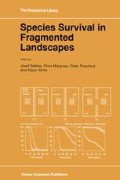Abstract
Despite the recent attention that has been given to extinctions (Fiedler & Ahouse 1992, Burgman et al. 1993, Lawton & May 1995), very little is known about the extinction process itself, primarily because determining causality afterwards is extremely difficult. Caughley (1994) recognised two paradigms in the study of extinction processes: extinction driven by agents external to the population in question (declining-population paradigm), and extinction resulting from stochastic processes in small populations (small-population paradigm).
Access this chapter
Tax calculation will be finalised at checkout
Purchases are for personal use only
Preview
Unable to display preview. Download preview PDF.
References
Arnold, G.W. & J.R. Weeldenburg (1991). The distributions and characteristics of remnant native vegetation in parts of the Kellerberrin, Tammin, Trayning and Wyalkatchem Shires of Western Australia. CSIRO, Canberra.
Bauer, A. & K. Henle (1994). Familia Gekkonidae (Reptilia, Sauria). Part I Australia and Oceania. - Das Tierreich 109, XIII + 306 pp.
Beard, J.S. (1980). The Vegetation of the Kellerberrin Area, Western Australia. Vegmap Publications, Perth
Burgman, M.A., S. Ferson, H.R., Akçakaya (1993). Risk Assessment in Conservation Biology. Chapman & Hall, London.
Bustard, H.R. (1968). The ecology of the Australian gecko, Gehyra variegata, in northern New South Wales. Journal of Zoology, London 154, 113–138.
Bustard, H.R. (1969). The population biology of the gekkonid lizard (Gehyra variegata (DUMÉRIL & BIBRON)) in exploited forests in northern New South Wales. Journal of Animal Ecology 38, 35–51.
Caughley, G. (1994). Directions in conservation biology. Journal of Animal Ecology 63, 215–244.
Caughley, G. & A. Gunn (1996). Conservation biology in theory and practice. Blackwell Science, Cambridge.
Chapman, A. & J. Dell (1980). Reptiles and frogs of Yorkrakine Rock, East Yorkrakine and North Bungulla nature reserves. Biological survey of the Western Australian wheatbelt. Part 11. Records of the Western Australian Museum Supplement 12, 69–73
Chapman, A. & J. Dell (1985). Biology and zoogeograpy of the amphibians and reptiles of the Western Australian wheatbelt. Records of the Western Australian Museum 12, 1–46.
Clark, R.L. (1990). Ecological history for environmental management. Proceedings of the Ecological Society of Australia 16, 1–21
Cogger, H.G. (1992). Reptiles and Amphibians of Australia. Reed International Books, Chatswood.
Dell, J. & A. Chapman (1978). Reptiles and frogs of Durokoppin and Kodj Kodjin nature reserves. Biological survey of the Western Australian wheatbelt. Part 6. Records of the Western Australian Museum Supplement 7, 69–74
Fiedler,P.L.,J.J. Ahouse (1992). Hierarchies of cause: Toward an understanding of rarity in vascular plant species. - In: P.L. Fiedler & S.K. Jain (eds.). Conservation Biology: The Theory and Practice of Nature Preservation and Management. Cambridge University Press, Cambridge, pp. 11–34
Goodman, D. (1987). The demography of chance extinction. - In: M.E. Soulé (ed.). Viable Populations for Conservation. Cambridge University Press, Cambridge, pp. 11–34.
Hanski, I. (1994) Spatial scale, patchiness and population dynamics on land. Philosophical Transactions of the Royal Society London B 343, 19–25.
Henle, K. (1990). Population ecology and life history evolution of the arboreal gecko Gehyra variegata in arid Australia. Herpetological Monographs 4, 30–60.
Henle,K. & B. Streit (1990). Kritische Betrachtungen zum Artenrückgang bei Amphibien und Reptilien und zu dessen Ursachen. Natur und Landschaft 65, 347–361
Hobbs, R.J. (1993). Effects of landscape fragmentation on ecosystem processes in the Western Australian wheatbelt. Biological Conservation 64,193–201.
Hopper, S.D. (1979). Biogeographical aspects of speciation in the southwest Australian flora. Annual Review of Ecology and Systematics 10, 399–422.
How, R.A. & D.J. Kitchener (1983). The biology of the gecko Oedura reticulata BUSTARD, in a small habitat isolate in the Western Australian wheatbelt. Biological Conservation 10, 543–556.
Kitchener,D.J.,A. Chapman,J. Dell & B.G., Muir,(1980).Lizard assemblage and reserve size and structure in the Western Australian wheatbelt - some implications for conservation. Biological Conservation 17, 25–62
Kitchener, D.J., R.A. How. & J. Dell (1988). Biology of Oedura reticulata and Gehyra variegata (Gekkonidae) in an isolated woodland of Western Australia. Journal of Herpetology 22, 401–412.
Lawton, J.H. & R.M. May (1995). Extinction Rates. Oxford University Press, Oxford.
Moritz, C. (1992). The population biology of Gehyra (Gekkonidae: Reptilia) III. Patterns of microgeographic variation. Journal of Evolutionary Biology 5, 661–676.
Pianka, E.R. (1986). Ecology and Natural History of Desert Lizards. Princeton University Press, Princeton.
Rabinowitz, D., S.Cairns. & T. Dillon (1986). Seven forms of rarity and their frequency in the flora of the British Isles. - In: M.E. Soule (ed.). Conservation Biology: The Science of Scarcity and Diversity. Sinauer Associates, Sunderland, pp. 182–204.
Sarre, S. (1995a). Size and structure of populations of Oedura reticulata (Gekkonidae) in woodland remnants: Implications for the future regional distribution of a currently common species. Australian Journal of Ecology 20, 288–298.
Sarre, S. (1995b). Mitochondrial DNA variation among populations of Oedura reticulata (Gekkonidae) in remnant vegetation: Implications for metapopulation structure and population decline. Molecular Ecology 4, 395–405.
Sarre, S. (in press). Habitat fragmentation promotes fluctuating asymmetry but not morphological divergence in two geckos. Researches on Population Ecology 38 (1).
Sarre, S., G.T. Smith.,J.A. Meyers (1995). Persistence of two species of gecko (Oedura reticulata and Gehyra variegata) in remnant habitat. Biological Conservation 71, 25–33
Saunders, D.A., R.J. Hobbs & C.R. Margules (1991). Biological consequences of ecosystem fragmentation: A review. Conservation Biology 5, 18–32.
Soulé, M.E. & K.A. Kohm (1989). Research Priorities for Conservation Biology. Island Press, Washington
Wiegand, K., R. Brandl, K. Henle, S. Sarre, T. Stephan., C. Wissel (in press). Extinctions in habitat remnants: Lessons from a specialized gecko species. Verhandlungen der Gesellschaft fur Okologie 25.
Author information
Authors and Affiliations
Editor information
Editors and Affiliations
Rights and permissions
Copyright information
© 1996 Kluwer Academic Publishers
About this chapter
Cite this chapter
Sarre, S., Wiegand, K., Henle, K. (1996). The Conservation Biology of a Specialist and a Generalist Gecko in the Fragmented Landscape of the Western Australian Wheatbelt. In: Settele, J., Margules, C., Poschlod, P., Henle, K. (eds) Species Survival in Fragmented Landscapes. The GeoJournal Library, vol 35. Springer, Dordrecht. https://doi.org/10.1007/978-94-009-0343-2_5
Download citation
DOI: https://doi.org/10.1007/978-94-009-0343-2_5
Publisher Name: Springer, Dordrecht
Print ISBN: 978-94-010-6640-2
Online ISBN: 978-94-009-0343-2
eBook Packages: Springer Book Archive

